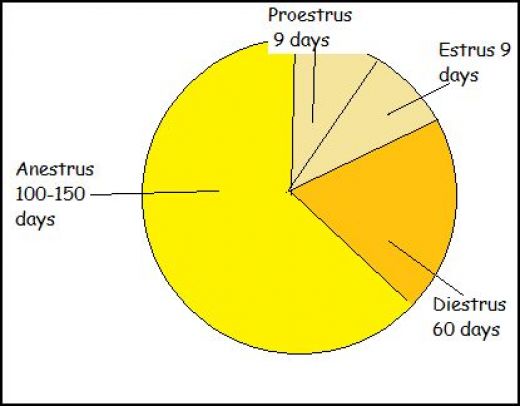Bitches, their Cycle and Seasons: When you first get a female puppy, any thoughts of them reaching sexual maturity is way off in the distance but from the age of around 5-7 months of age, a female dog is generally considered to be mature. There is of course considerable variation within the different breeds with the larger and giant breeds maturing more slowly. So although it is normal for a bitch to have her first season around the 6 month mark, it is perfectly normal for it to happen much later – even up to 2 years old in some cases.
When she is very first “on heat”, it is not uncommon for this first cycle to go completely unnoticed by the owner as the duration of the cycle from start to finish may be much shorter the first time around and also few of the external signs may be visible.
Once maturity is reached, then it is normal to have two cycles or “seasons” per year, but each dog has her own cycle and for some the norm may be every 7-9 months – once again, this is very much down to the individual bitch and is totally normal.
We can pretty much divide the oestrus cycle into four sections – all with medical names ie Anoestrus, Pro-oestrus, Oestrus and finally Metoestrus, but for ease of understanding, we’ll just call them parts 1,2,3 and 4.
Part 1:
This first part of the cycle is where there is pretty much nothing going on within the reproductive tract and the phase lasts for about 3-4 months or thereabouts, depending on the full length of her entire cycle. She will show no signs or changes and male dogs will have no sexual interest in her.
Part 2:
The next phase lasts for around 10 days or so and is the beginning of her “heat” period. You will notice her vulva begin to swell up (this can be quite marked as time goes on) and she will produce a clear then blood stained discharge from her vagina. She may become nervous or “grippy” with you and need reassurance and comfort. This is the phase where she starts to become desirable to the boys …. but she is not ready for mating at this point and will not allow it to take place, regardless of their persuasive efforts!
Part 3:
Phase 3 lasts for around 10 days or so too. This part of the cycle marks the beginning of the receptive stage – the stage at which she is most receptive to a dog’s advances.
FOR THOSE WISHING TO AVOID A PREGNANCY, STAGE 3 IS THE MOST “DANGEROUS” TIME AND THE TIME TO KEEP YOUR HAWK EYE FIRMLY ON HER AND ANY LOCAL LOTHARIOS.
During this phase she will continue to produce a red discharge from the vulva but the consistency of the discharge will likely change and become more bloody and less watery in appearance and then stop. During this time the bitch may become more alert and urinate more frequently as she broadcasts signals of her impending willingness to mate.
Ovulation will usually take place within the first few days of this phase, so if we take the start of phase 2 as day 1, then ovulation should happen on or around two weeks following day 1. The time at which she ovulates will be the time she is happy to accept a male “suiter” and the time at which mating is most likely to be successful. It is important to keep in mind that each bitch is unique and her cycle can only be estimated.
Part 4:
Because hormonal changes take place during stage 4 irrespective of whether the mating was successful or not, a simple blood or urine test to confirm pregnancy is not possible. It is simply a waiting game followed by a visit to your vet to confirm that the bitch is indeed in whelp.
If a successful mating does not take place, phase 4 of the cycle will last for around 2-3 months. During this phase, the uterine wall thickens and outwardly there are no visible signs. A bitch can experience hormonal fluctuations and these peaks and troughs can result in a false or “Phantom” pregnancy (we’ll look at that in tomorrow’s blog).
So there you have it, the anatomical side of things so far as our girls go. But what about their emotional and behavioural sides? Well, this is something we should also consider and I am very grateful to my friend Ray Hobbs of Canine Harmony Wales for writing the following blog that explains things in a clear and understandable manner.
Thank you very much Ray.
http://canineharmonywales.wordpress.com/2014/02/05/puppys-first-season/
.

